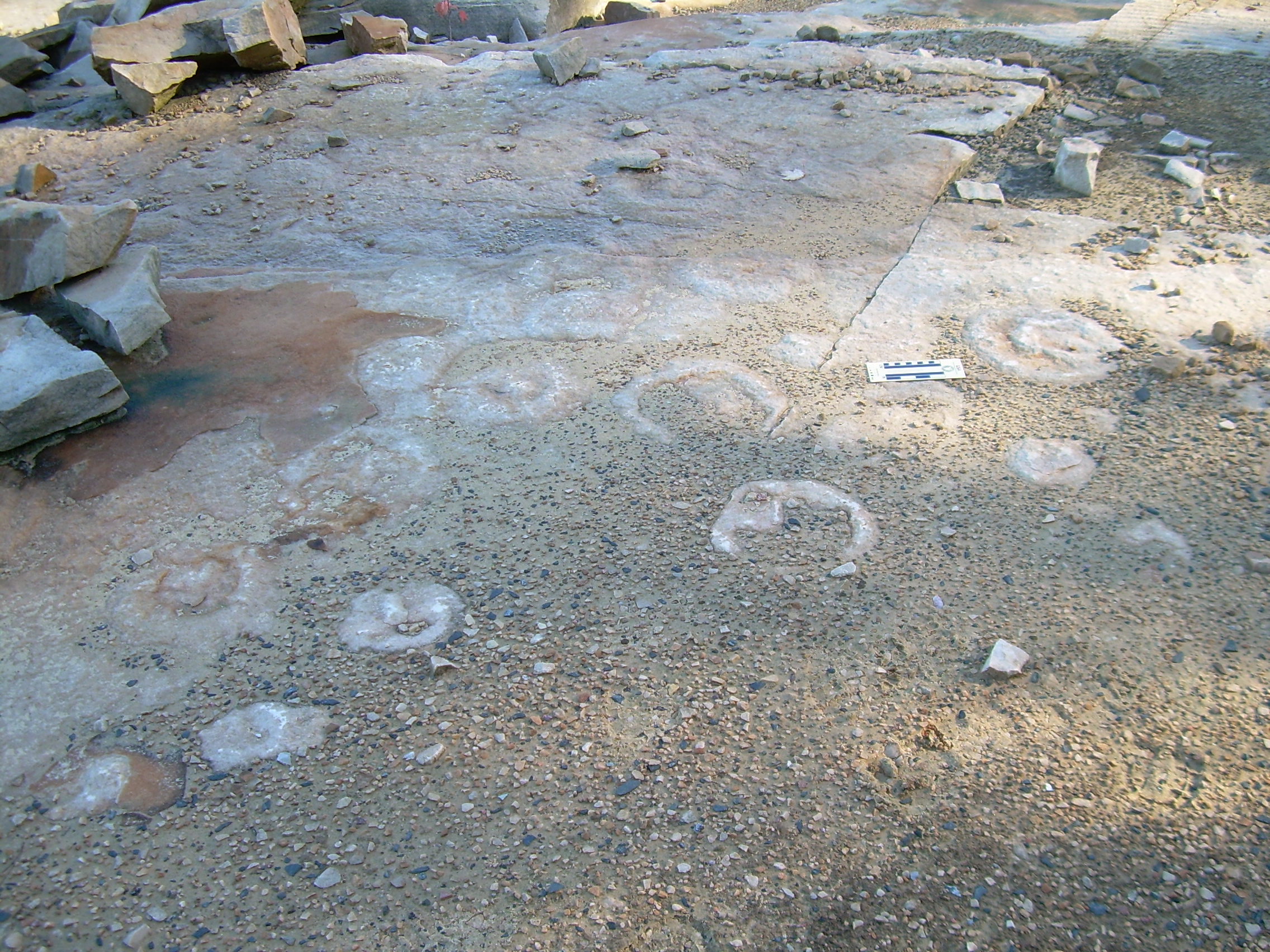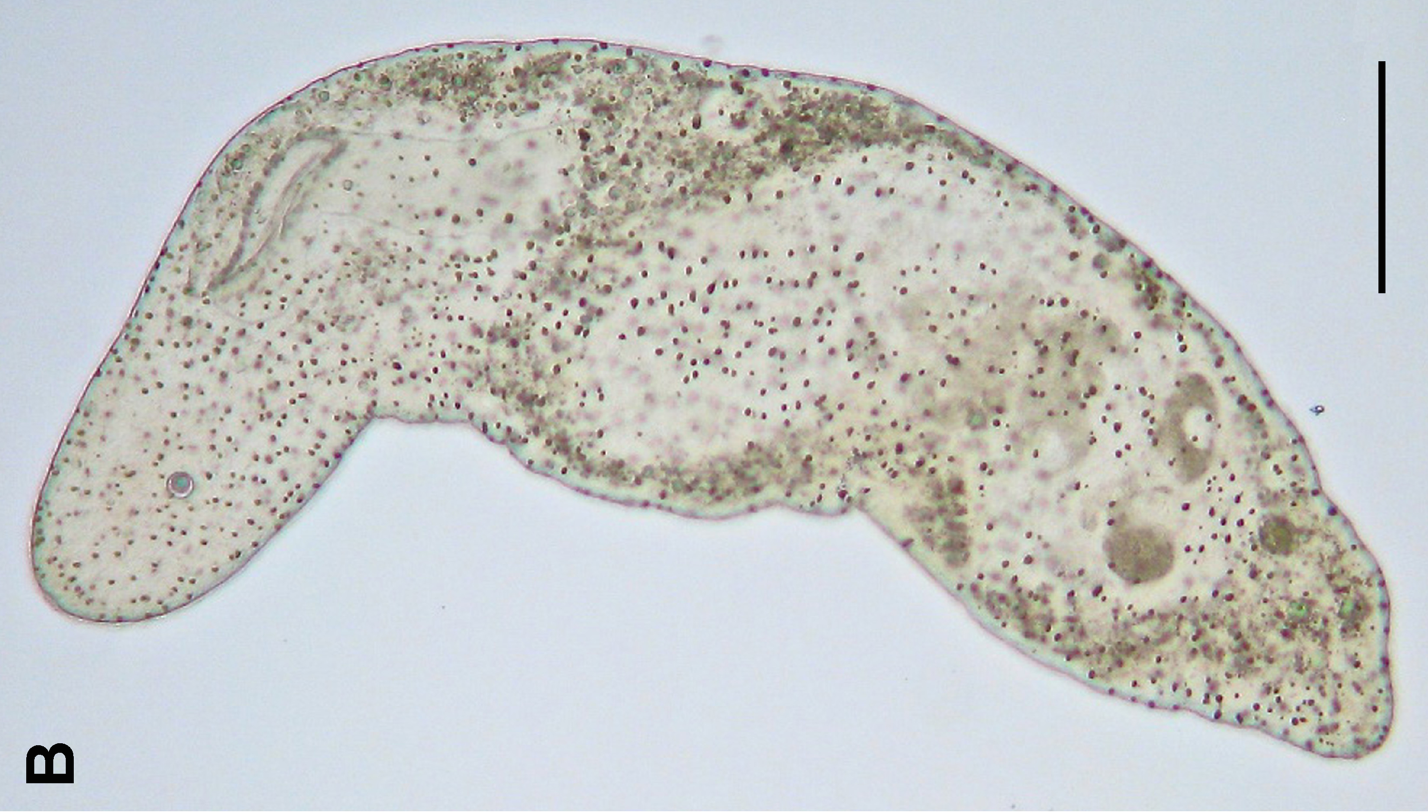|
Eldoniidae
Eldoniids are an extinct clade of enigmatic disc-shaped animals which lived in the early to middle Paleozoic (Cambrian to Devonian). They are characterized by their "medusoid" ( jellyfish-shaped) bodies, with the form of a shallow dome opening below to an offset mouth supplemented by filamentous tentacles. Internally, they have a distinctive C-shaped cavity encompassing the gut, as well as hollow radial (radiating) structures arranged around a central ring canal. Most eldoniids are soft-bodied and can only be preserved in lagerstätten, but a few species may have hosted mineralized deposits. Historically, the affinities of eldoniids was enigmatic; recently, they been assessed as cambroernid deuterostomes. Their lifestyle is still an unresolved question; some authors reconstruct eldoniids as free-floating planktonic predators similar to jellyfish, while others argue that they were passive detritivores, embedded within the seabed for much of their life. Classification Eldoniids ... [...More Info...] [...Related Items...] OR: [Wikipedia] [Google] [Baidu] |
Eldonia Berbera 1
''Eldonia'' is an extinct soft-bodied cambroernid animal of unknown affinity, best known from the Fossil Ridge outcrops of the Burgess Shale, particularly in the 'Great ''Eldonia'' layer' in the Walcott Quarry. In addition to the 550 collected by Walcott, 224 specimens of ''Eldonia'' are known from the Greater Phyllopod bed, where they comprise 0.43% of the community. Species also occur in the Chengjiang biota, Siberia, and in Upper Ordovician strata of Morocco. Walcott's original interpretation as a holothurian was rapidly disputed. Alternative affinities to be suggested, which did not stand the test of time, included the siphonophores and a coelenterate medusa. It takes the form of a round, medusoid disk (which originally led to suggestions of a jellyfish affinity) with a C-shaped gut trace. The gut is recalcitrant and can be extracted using Hydrofluoric acid Hydrofluoric acid is a Solution (chemistry), solution of hydrogen fluoride (HF) in water. Solutions of HF ar ... [...More Info...] [...Related Items...] OR: [Wikipedia] [Google] [Baidu] |
Cnidaria
Cnidaria () is a phylum under kingdom Animalia containing over 11,000 species of aquatic animals found both in Fresh water, freshwater and Marine habitats, marine environments, predominantly the latter. Their distinguishing feature is cnidocytes, specialized cells that they use mainly for capturing prey. Their bodies consist of mesoglea, a non-living jelly-like substance, sandwiched between two layers of epithelium that are mostly one cell (biology), cell thick. Cnidarians mostly have two basic body forms: swimming Medusa (biology), medusae and Sessility (motility), sessile polyp (zoology), polyps, both of which are Symmetry (biology)#Radial symmetry, radially symmetrical with mouths surrounded by tentacles that bear cnidocytes. Both forms have a single Body orifice, orifice and body cavity that are used for digestion and respiration (physiology), respiration. Many cnidarian species produce Colony (biology), colonies that are single organisms composed of medusa-like or polyp (z ... [...More Info...] [...Related Items...] OR: [Wikipedia] [Google] [Baidu] |
Scyphozoa
The Scyphozoa are an exclusively marine class of the phylum Cnidaria, referred to as the true jellyfish (or "true jellies"). The class name Scyphozoa comes from the Greek word '' skyphos'' (), denoting a kind of drinking cup and alluding to the cup shape of the organism. Scyphozoans have existed from the earliest Cambrian to the present. Biology Most species of Scyphozoa have two life-history phases, including the planktonic medusa or polyp form, which is most evident in the warm summer months, and an inconspicuous, but longer-lived, bottom-dwelling polyp, which seasonally gives rise to new medusae. Most of the large, often colorful, and conspicuous jellyfish found in coastal waters throughout the world are Scyphozoa. They typically range from in diameter, but the largest species, '' Cyanea capillata'' can reach across. Scyphomedusae are found throughout the world's oceans, from the surface to great depths; no Scyphozoa occur in freshwater (or on land). As medusae, they eat ... [...More Info...] [...Related Items...] OR: [Wikipedia] [Google] [Baidu] |
Morocco
Morocco (),, ) officially the Kingdom of Morocco, is the westernmost country in the Maghreb region of North Africa. It overlooks the Mediterranean Sea to the north and the Atlantic Ocean to the west, and has land borders with Algeria to the east, and the disputed territory of Western Sahara to the south. Mauritania lies to the south of Western Sahara. Morocco also claims the Spanish exclaves of Ceuta, Melilla and Peñón de Vélez de la Gomera, and several small Spanish-controlled islands off its coast. It spans an area of or , with a population of roughly 37 million. Its official and predominant religion is Islam, and the official languages are Arabic and Berber; the Moroccan dialect of Arabic and French are also widely spoken. Moroccan identity and culture is a mix of Arab, Berber, and European cultures. Its capital is Rabat, while its largest city is Casablanca. In a region inhabited since the Paleolithic Era over 300,000 years ago, the first Moroccan st ... [...More Info...] [...Related Items...] OR: [Wikipedia] [Google] [Baidu] |
Tafilalt Biota
Tafilalt or Tafilet (; ar, تافيلالت), historically Sijilmasa, is a region and the largest oasis in Morocco. Etymology The word "Tafilalt" is an Amazigh word and it means "Jug", which is specifically a pottery jar used to store water. History Although previous settlements existed, especially during the Roman period, the first continuously inhabited town in the area after the spread of Islam was Sijilmasa, founded by the Amazigh Miknasa tribal leader Moussa ben Nasser in 757 CE. It was on the direct caravan route from the Niger river to Tangier, and attained a considerable degree of prosperity. In the 17th century, the Alaouite dynasty of Morocco first achieved political ascendancy in Tafilalt, and in 1606 the Sultan Zidan al-Nasir hid in Tafilalt, where he made a profit off of gold mined in the area, built an army, eventually taking control of the city of Marrakech. A few years later in 1610, Ahmed ibn Abi Mahalli also built up an army in the Tafilalt area and took Marrak ... [...More Info...] [...Related Items...] OR: [Wikipedia] [Google] [Baidu] |
Late Ordovician
The Ordovician ( ) is a geologic period and system, the second of six periods of the Paleozoic Era. The Ordovician spans 41.6 million years from the end of the Cambrian Period million years ago (Mya) to the start of the Silurian Period Mya. The Ordovician, named after the Welsh tribe of the Ordovices, was defined by Charles Lapworth in 1879 to resolve a dispute between followers of Adam Sedgwick and Roderick Murchison, who were placing the same rock beds in North Wales in the Cambrian and Silurian systems, respectively. Lapworth recognized that the fossil fauna in the disputed strata were different from those of either the Cambrian or the Silurian systems, and placed them in a system of their own. The Ordovician received international approval in 1960 (forty years after Lapworth's death), when it was adopted as an official period of the Paleozoic Era by the International Geological Congress. Life continued to flourish during the Ordovician as it did in the earlier Cambrian ... [...More Info...] [...Related Items...] OR: [Wikipedia] [Google] [Baidu] |
Burgess Shale
The Burgess Shale is a fossil-bearing deposit exposed in the Canadian Rockies of British Columbia, Canada. It is famous for the exceptional preservation of the soft parts of its fossils. At old (middle Cambrian), it is one of the earliest fossil beds containing soft-part imprints. The rock unit is a black shale and crops out at a number of localities near the town of Field in Yoho National Park and the Kicking Horse Pass. Another outcrop is in Kootenay National Park 42 km to the south. History and significance The Burgess Shale was discovered by palaeontologist Charles Walcott on 30 August 1909, towards the end of the season's fieldwork. He returned in 1910 with his sons, daughter, and wife, establishing a quarry on the flanks of Fossil Ridge. The significance of soft-bodied preservation, and the range of organisms he recognised as new to science, led him to return to the quarry almost every year until 1924. At that point, aged 74, he had amassed over 65,000 ... [...More Info...] [...Related Items...] OR: [Wikipedia] [Google] [Baidu] |
Eldonia
''Eldonia'' is an extinct soft-bodied cambroernid animal of unknown affinity, best known from the Fossil Ridge outcrops of the Burgess Shale, particularly in the 'Great ''Eldonia'' layer' in the Walcott Quarry. In addition to the 550 collected by Walcott, 224 specimens of ''Eldonia'' are known from the Greater Phyllopod bed, where they comprise 0.43% of the community. Species also occur in the Chengjiang biota, Siberia, and in Upper Ordovician strata of Morocco. Walcott's original interpretation as a holothurian was rapidly disputed. Alternative affinities to be suggested, which did not stand the test of time, included the siphonophores and a coelenterate medusa. It takes the form of a round, medusoid disk (which originally led to suggestions of a jellyfish affinity) with a C-shaped gut trace. The gut is recalcitrant and can be extracted using Hydrofluoric acid. The organism is frequently found in association with the lobopod ''Microdictyon ''Microdictyon'' is an extinct a ... [...More Info...] [...Related Items...] OR: [Wikipedia] [Google] [Baidu] |
Family (biology)
Family ( la, familia, plural ') is one of the eight major hierarchical taxonomic ranks in Linnaean taxonomy. It is classified between order and genus. A family may be divided into subfamilies, which are intermediate ranks between the ranks of family and genus. The official family names are Latin in origin; however, popular names are often used: for example, walnut trees and hickory trees belong to the family Juglandaceae, but that family is commonly referred to as the "walnut family". What belongs to a family—or if a described family should be recognized at all—are proposed and determined by practicing taxonomists. There are no hard rules for describing or recognizing a family, but in plants, they can be characterized on the basis of both vegetative and reproductive features of plant species. Taxonomists often take different positions about descriptions, and there may be no broad consensus across the scientific community for some time. The publishing of new data and opi ... [...More Info...] [...Related Items...] OR: [Wikipedia] [Google] [Baidu] |
Hemichordate
Hemichordata is a phylum which consists of triploblastic, enterocoelomate, and bilaterally symmetrical marine deuterostome animals, generally considered the sister group of the echinoderms. They appear in the Lower or Middle Cambrian and include two main classes: Enteropneusta (acorn worms), and Pterobranchia. A third class, Planctosphaeroidea, is known only from the larva of a single species, '' Planctosphaera pelagica''. The class Graptolithina, formerly considered extinct, is now placed within the pterobranchs, represented by a single living genus ''Rhabdopleura''. Acorn worms are solitary worm-shaped organisms. They generally live in burrows (the earliest secreted tubes) and are deposit feeders, but some species are pharyngeal filter feeders, while the family Torquaratoridae are free living detritivores. Many are well known for their production and accumulation of various halogenated phenols and pyrroles. Pterobranchs are filter-feeders, mostly colonial, living in a collag ... [...More Info...] [...Related Items...] OR: [Wikipedia] [Google] [Baidu] |
Echinoderm
An echinoderm () is any member of the phylum Echinodermata (). The adults are recognisable by their (usually five-point) radial symmetry, and include starfish, brittle stars, sea urchins, sand dollars, and sea cucumbers, as well as the sea lilies or "stone lilies". Adult echinoderms are found on the sea bed at every ocean depth, from the intertidal zone to the abyssal zone. The phylum contains about 7,000 living species, making it the second-largest grouping of deuterostomes, after the chordates. Echinoderms are the largest entirely marine phylum. The first definitive echinoderms appeared near the start of the Cambrian. The echinoderms are important both ecologically and geologically. Ecologically, there are few other groupings so abundant in the biotic desert of the deep sea, as well as shallower oceans. Most echinoderms are able to reproduce asexually and regenerate tissue, organs, and limbs; in some cases, they can undergo complete regeneration from a single limb. ... [...More Info...] [...Related Items...] OR: [Wikipedia] [Google] [Baidu] |



